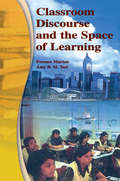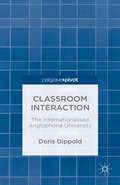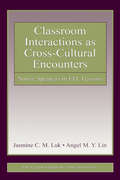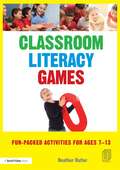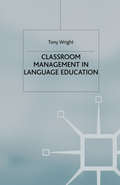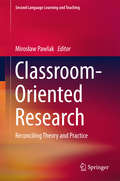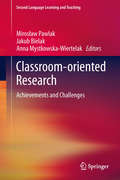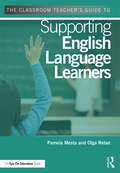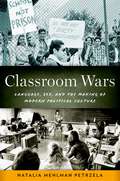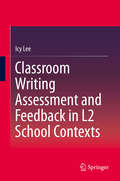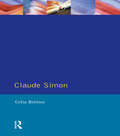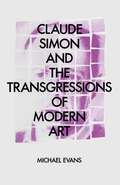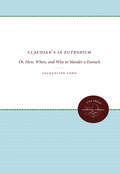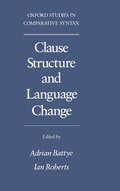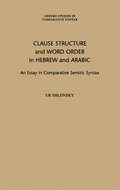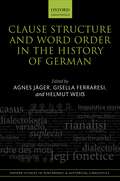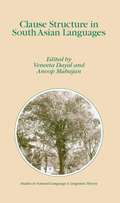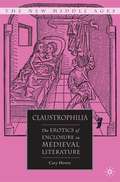- Table View
- List View
Classroom Discourse and the Space of Learning
by Ference Marton Amy B.M. Tsui Pakey P.M. Chik Po Yuk Ko Mun Ling LoClassroom Discourse and the Space of Learning is about learning in schools and the central role of language in learning. The investigations of learning it reports are based on two premises: First, whatever you are trying to learn, there are certain necessary conditions for succeeding--although you cannot be sure that learning will take place when those conditions are met, you can be sure that no learning will occur if they are not. The limits of what is possible to learn is what the authors call "the space of learning." Second, language plays a central role in learning--it does not merely convey meaning, it also creates meaning. The book explicates the necessary conditions for successful learning and employs investigations of classroom discourse data to demonstrate how the space of learning is linguistically constituted in the classroom.Classroom Discourse and the Space of Learning:*makes the case that an understanding of how the space of learning is linguistically constituted in the classroom is best achieved through investigating "classroom discourse" and that finding out what the conditions are for successful learning and bringing them about should be the teacher's primary professional task. Thus, it is fundamentally important for teachers and student teachers to be given opportunities to observe different teachers teaching the same thing, and to analyze and reflect on whether the classroom discourse in which they are engaged maximizes or minimizes the conditions for learning;*is both more culturally situated and more generalizable than many other studies of learning in schools. Each case of classroom teaching clearly demonstrates how the specific language, culture, and pedagogy molds what is happening in the classroom, yet at the same time it is possible to generalize from these culturally specific examples the necessary conditions that must be met for the development of any specific capability regardless of where the learning is taking place and what other conditions might be present; and *encompasses both theory and practice--providing a detailed explication of the theory of learning underlying the analyses of classroom teaching reported, along with close analyses of a number of authentic cases of classroom teaching driven by classroom discourse data which have practical relevance for teachers.Intended for researchers and graduate students in education, teacher educators, and student teachers, Classroom Discourse and the Space of Learning is practice- and content-oriented, theoretical, qualitative, empirical, and focused on language, and links teaching and learning in significant new ways.
Classroom Discourse and the Space of Learning
by Ference Marton Amy B.M. Tsui Pakey P.M. Chik Po Yuk Ko Mun Ling LoClassroom Discourse and the Space of Learning is about learning in schools and the central role of language in learning. The investigations of learning it reports are based on two premises: First, whatever you are trying to learn, there are certain necessary conditions for succeeding--although you cannot be sure that learning will take place when those conditions are met, you can be sure that no learning will occur if they are not. The limits of what is possible to learn is what the authors call "the space of learning." Second, language plays a central role in learning--it does not merely convey meaning, it also creates meaning. The book explicates the necessary conditions for successful learning and employs investigations of classroom discourse data to demonstrate how the space of learning is linguistically constituted in the classroom.Classroom Discourse and the Space of Learning:*makes the case that an understanding of how the space of learning is linguistically constituted in the classroom is best achieved through investigating "classroom discourse" and that finding out what the conditions are for successful learning and bringing them about should be the teacher's primary professional task. Thus, it is fundamentally important for teachers and student teachers to be given opportunities to observe different teachers teaching the same thing, and to analyze and reflect on whether the classroom discourse in which they are engaged maximizes or minimizes the conditions for learning;*is both more culturally situated and more generalizable than many other studies of learning in schools. Each case of classroom teaching clearly demonstrates how the specific language, culture, and pedagogy molds what is happening in the classroom, yet at the same time it is possible to generalize from these culturally specific examples the necessary conditions that must be met for the development of any specific capability regardless of where the learning is taking place and what other conditions might be present; and *encompasses both theory and practice--providing a detailed explication of the theory of learning underlying the analyses of classroom teaching reported, along with close analyses of a number of authentic cases of classroom teaching driven by classroom discourse data which have practical relevance for teachers.Intended for researchers and graduate students in education, teacher educators, and student teachers, Classroom Discourse and the Space of Learning is practice- and content-oriented, theoretical, qualitative, empirical, and focused on language, and links teaching and learning in significant new ways.
Classroom Interaction: The Internationalised Anglophone University
by Doris DippoldInternationalisation has had a forceful impact on universities across the Anglophone world. This book reviews what we know about interaction in the Anglophone university classroom, describes the challenges students and tutors face, and illustrates how they can overcome these challenges by drawing on their own experiences and practices.
Classroom Interactions as Cross-Cultural Encounters: Native Speakers in EFL Lessons (ESL & Applied Linguistics Professional Series)
by Jasmine C. Luk Angel M. LinClassroom Interactions as Cross-Cultural Encounters is about native English speakers teaching English as a global language in non-English speaking countries. Through analysis of naturally occurring dialogic encounters, the authors examine the multifaceted ways in which teachers and students utilize diverse communicative resources to construct, display, and negotiate their identities as teachers, learners, and language users, with different pedagogic, institutional, social, and political implications. A range of issues in applied linguistics is addressed, including linguistic imperialism, post-colonial theories, micropolitics of classroom interaction, language and identity, and bilingual classroom practices. Intended to help TESOL professionals of different cultural backgrounds, working in different sociocultural contexts, to critically understand how non-assimilationist, dialogic intercultultural communication with students can be achieved and built on for mutual cultural and linguistic enrichment and empowerment, this book:*emphasizes the sociocultural meanings and micropolitics of classroom interactions that reveal the complex realities of power and identity negotiations in cross-cultural interactions in ELT (English Language Teaching) classroom contexts;*revisits and reconstitutes the notion of native-speakerness and repositions the roles of native and non-native English teachers in the TESOL profession in the contexts of decolonization and globalization; *highlights the need to mobilize intercultural communicative resources for global communication;*addresses two major concerns of EFL (English as a Foreign Language) classroom researchers and teachers: student resistance and learning motivation; and*examines and analyzes the changing ideologies (both explicit and implicit) of teachers and students about English learning in the context of a post-colonial society, and how these ideologies are being enacted, reproduced, but also sometimes contested in EFL classroom interactions. Each chapter includes Questions for Reflection and Discussion to promote critical thinking and understanding of the issues discussed. Tuning-In discussion questions are provided in the three chapters on classroom data analysis to activate readers interpretive schemas before they examine the actual classroom episodes. The data are from an ethnographic study in post-colonial Hong Kong secondary schools involving four native English-speaker teachers and two bilingual Cantonese-English speaking teachers engaged in intercultural classroom dialogues with their Cantonese Hong Kong students. The rich, naturally occurring classroom data and in-depth analyses provide useful pedagogical materials for courses in EFL teacher education programs on classroom discourse analysis from sociocultural perspectives.
Classroom Interactions as Cross-Cultural Encounters: Native Speakers in EFL Lessons (ESL & Applied Linguistics Professional Series)
by Jasmine C. Luk Angel M. LinClassroom Interactions as Cross-Cultural Encounters is about native English speakers teaching English as a global language in non-English speaking countries. Through analysis of naturally occurring dialogic encounters, the authors examine the multifaceted ways in which teachers and students utilize diverse communicative resources to construct, display, and negotiate their identities as teachers, learners, and language users, with different pedagogic, institutional, social, and political implications. A range of issues in applied linguistics is addressed, including linguistic imperialism, post-colonial theories, micropolitics of classroom interaction, language and identity, and bilingual classroom practices. Intended to help TESOL professionals of different cultural backgrounds, working in different sociocultural contexts, to critically understand how non-assimilationist, dialogic intercultultural communication with students can be achieved and built on for mutual cultural and linguistic enrichment and empowerment, this book:*emphasizes the sociocultural meanings and micropolitics of classroom interactions that reveal the complex realities of power and identity negotiations in cross-cultural interactions in ELT (English Language Teaching) classroom contexts;*revisits and reconstitutes the notion of native-speakerness and repositions the roles of native and non-native English teachers in the TESOL profession in the contexts of decolonization and globalization; *highlights the need to mobilize intercultural communicative resources for global communication;*addresses two major concerns of EFL (English as a Foreign Language) classroom researchers and teachers: student resistance and learning motivation; and*examines and analyzes the changing ideologies (both explicit and implicit) of teachers and students about English learning in the context of a post-colonial society, and how these ideologies are being enacted, reproduced, but also sometimes contested in EFL classroom interactions. Each chapter includes Questions for Reflection and Discussion to promote critical thinking and understanding of the issues discussed. Tuning-In discussion questions are provided in the three chapters on classroom data analysis to activate readers interpretive schemas before they examine the actual classroom episodes. The data are from an ethnographic study in post-colonial Hong Kong secondary schools involving four native English-speaker teachers and two bilingual Cantonese-English speaking teachers engaged in intercultural classroom dialogues with their Cantonese Hong Kong students. The rich, naturally occurring classroom data and in-depth analyses provide useful pedagogical materials for courses in EFL teacher education programs on classroom discourse analysis from sociocultural perspectives.
Classroom Literacy Games: Fun-packed activities for ages 7-13
by Heather ButlerChildren enjoyed it so much they didn’t realise they were being worked so hard.Jo Miles, Learning Support Assistant at Manor Farm Community Junior School, Hazlemere, Buckinghamshire Great speaking and listening activity-setting-up ideas for the Big Write. The games extended the children’s vocabulary. Purposeful learning – love it!Liz Pilgrim, Senior Teacher at Manor Farm Community Junior School, Hazlemere, Buckinghamshire Educational games played in groups or pairs help develop key language and social skills. Based on a range of material to extend vocabulary, punctuation and cross-curricular creativity, Classroom Literacy Games contains original games with suggestions of how to develop writing tasks after playing them. Each game is differentiated four ways and aims to teach literacy (including vocabularly, connectives, openers and punctuation) to higher KS1, KS2 and lower KS3. Printed with dyslexia-friendly fonts, these cross-curricular games are suitable for mixed-ability classrooms, small groups or one-to-one teaching situations. As either photocopiable resources to be used in the classroom or as homework activities, these games will create situations to generate creative writing and for the children to create their own games. They can also be used for EAL, guided reading and weekly Big Write exercises. With minimal preparation time required and a vast number of games, these user-friendly, pick-up-and-go activities will be of interest to any practicing primary and lower KS3 teacher.
Classroom Literacy Games: Fun-packed activities for ages 7-13
by Heather ButlerChildren enjoyed it so much they didn’t realise they were being worked so hard.Jo Miles, Learning Support Assistant at Manor Farm Community Junior School, Hazlemere, Buckinghamshire Great speaking and listening activity-setting-up ideas for the Big Write. The games extended the children’s vocabulary. Purposeful learning – love it!Liz Pilgrim, Senior Teacher at Manor Farm Community Junior School, Hazlemere, Buckinghamshire Educational games played in groups or pairs help develop key language and social skills. Based on a range of material to extend vocabulary, punctuation and cross-curricular creativity, Classroom Literacy Games contains original games with suggestions of how to develop writing tasks after playing them. Each game is differentiated four ways and aims to teach literacy (including vocabularly, connectives, openers and punctuation) to higher KS1, KS2 and lower KS3. Printed with dyslexia-friendly fonts, these cross-curricular games are suitable for mixed-ability classrooms, small groups or one-to-one teaching situations. As either photocopiable resources to be used in the classroom or as homework activities, these games will create situations to generate creative writing and for the children to create their own games. They can also be used for EAL, guided reading and weekly Big Write exercises. With minimal preparation time required and a vast number of games, these user-friendly, pick-up-and-go activities will be of interest to any practicing primary and lower KS3 teacher.
Classroom Management in Language Education (Research and Practice in Applied Linguistics)
by T. WrightA book that develops an understanding of practices at the very centre of language education - the classroom. It is written for postgraduate students in Applied Linguistics and Education, and practitioners, whether in TESOL or other language teaching, In Part 1 the author explores key concepts in unpacking the complexity of classroom life. In Part 2 existing research and practice are examined through a series of research case studies. Part 3 provides a template for research activity and suggestions for projects and methodologies, and Part 4 collects resources for readers keen to follow up the themes developed in the book.
Classroom-Oriented Research: Reconciling Theory and Practice (Second Language Learning and Teaching)
by Mirosław PawlakThis collection gathers contributions from scholars from Poland and abroad addressing different facets of research into the processes of foreign-language and second-language learning and teaching as they transpire in a typical language classroom. The book is divided into three parts, which address in turn: research directions and methodology, the findings of empirical research, and links between theoretical considerations and classroom practice. Accordingly, the first part includes papers that examine the role of different research paradigms, put forward concrete research proposals, present innovative data gathering tools or assess the role of such instruments in language teaching. The second part includes reports on original research studies focusing e.g. on teachers’ beliefs, the role of lexis and pragmatics, the application of modern technologies, the teaching and assessment of primary school children, and the development of social skills from a cross-cultural perspective. Finally, the third part of the book demonstrates how theory-driven approaches can enhance the effectiveness of instructed second language acquisition.
Classroom-oriented Research: Achievements and Challenges (Second Language Learning and Teaching)
by Mirosław Pawlak Jakub Bielak Anna Mystkowska-WiertelakThe volume brings together papers related to different aspects of classroom-oriented research on teaching and learning second and foreign languages that have been authored by specialists from Poland and abroad. The first part contains contributions dealing with individual variation in the language classroom, in particular age, anxiety, beliefs and language learning strategies. The second part deals with various facets of teachers’ behaviors in the classroom, focusing in particular on classroom communication and the use of action research in teacher training. The third part includes papers devoted to various instructional practices, such as the use of new technologies, the development of intercultural competence, assessment or combining content and language. Finally, the last part deals with issues involved in research methodology, with special emphasis being placed on the use of diaries, observations, mixed methods research as well as triangulation.
The Classroom Teacher's Guide to Supporting English Language Learners
by Pamela Mesta Olga ReberThis book answers your key questions about educating English Language Learners (ELLs) and offers detailed guidance and concrete applications for your classroom. Designed as a one-stop-shop for classroom teachers of all grade levels and content areas, this book is chock full of essential information, delivered in a practical, concise format. In each chapter, you will find checklists, instructional strategies, tables, tools and ideas for next steps. The resources and examples provided are easy to implement and can be used the next day in your teaching. Topics addressed include: Getting to know your ELLs Considering how culture, language and academic background impact learning Bridging the home/school connection Pairing content and language objectives Gauging learner progress Collaborating with ELL staff Much more!
Classroom Wars: Language, Sex, and the Making of Modern Political Culture
by Natalia Mehlman PetrzelaThe schoolhouse has long been a crucible in the construction and contestation of the political concept of "family values." Through Spanish-bilingual and sex education, moderates and conservatives in California came to define the family as a politicized and racialized site in the late 1960s and 1970s. Sex education became a vital arena in the culture wars as cultural conservatives imagined the family as imperiled by morally lax progressives and liberals who advocated for these programs attempted to manage the onslaught of sexual explicitness in broader culture. Many moderates, however, doubted the propriety of addressing such sensitive issues outside the home. Bilingual education, meanwhile, was condemned as a symbol of wasteful federal spending on ethically questionable curricula and an intrusion on local prerogative. Spanish-language bilingual-bicultural programs may seem less relevant to the politics of family, but many Latino parents and students attempted to assert their authority, against great resistance, in impassioned demands to incorporate their cultural and linguistic heritage into the classroom. Both types of educational programs, in their successful implementation and in the reaction they inspired, highlight the rightward turn and enduring progressivism in postwar American political culture. In Classroom Wars, Natalia Mehlman Petrzela charts how a state and a citizenry deeply committed to public education as an engine of civic and moral education navigated the massive changes brought about by the 1960s, including the sexual revolution, school desegregation, and a dramatic increase in Latino immigration. She traces the mounting tensions over educational progressivism, cultural and moral decay, and fiscal improvidence, using sources ranging from policy documents to student newspapers, from course evaluations to oral histories. Petrzela reveals how a growing number of Americans fused values about family, personal, and civic morality, which galvanized a powerful politics that engaged many Californians and, ultimately, many Americans. In doing so, they blurred the distinction between public and private and inspired some of the fiercest classroom wars in American history. Taking readers from the cultures of Orange County mega-churches to Berkeley coffeehouses, Natalia Mehlman Petrzela's history of these classroom controversies sheds light on the bitterness of the battles over diversity we continue to wage today and their influence on schools and society nationwide.
Classroom Wars: Language, Sex, and the Making of Modern Political Culture
by Natalia Mehlman PetrzelaThe schoolhouse has long been a crucible in the construction and contestation of the political concept of "family values." Through Spanish-bilingual and sex education, moderates and conservatives in California came to define the family as a politicized and racialized site in the late 1960s and 1970s. Sex education became a vital arena in the culture wars as cultural conservatives imagined the family as imperiled by morally lax progressives and liberals who advocated for these programs attempted to manage the onslaught of sexual explicitness in broader culture. Many moderates, however, doubted the propriety of addressing such sensitive issues outside the home. Bilingual education, meanwhile, was condemned as a symbol of wasteful federal spending on ethically questionable curricula and an intrusion on local prerogative. Spanish-language bilingual-bicultural programs may seem less relevant to the politics of family, but many Latino parents and students attempted to assert their authority, against great resistance, in impassioned demands to incorporate their cultural and linguistic heritage into the classroom. Both types of educational programs, in their successful implementation and in the reaction they inspired, highlight the rightward turn and enduring progressivism in postwar American political culture. In Classroom Wars, Natalia Mehlman Petrzela charts how a state and a citizenry deeply committed to public education as an engine of civic and moral education navigated the massive changes brought about by the 1960s, including the sexual revolution, school desegregation, and a dramatic increase in Latino immigration. She traces the mounting tensions over educational progressivism, cultural and moral decay, and fiscal improvidence, using sources ranging from policy documents to student newspapers, from course evaluations to oral histories. Petrzela reveals how a growing number of Americans fused values about family, personal, and civic morality, which galvanized a powerful politics that engaged many Californians and, ultimately, many Americans. In doing so, they blurred the distinction between public and private and inspired some of the fiercest classroom wars in American history. Taking readers from the cultures of Orange County mega-churches to Berkeley coffeehouses, Natalia Mehlman Petrzela's history of these classroom controversies sheds light on the bitterness of the battles over diversity we continue to wage today and their influence on schools and society nationwide.
Classroom Writing Assessment and Feedback in L2 School Contexts
by Icy LeeWhile assessment and feedback tend to be treated separately in the L2 writing literature, this book brings together these two essential topics and examines how effective classroom assessment and feedback can provide a solid foundation for the successful teaching and learning of writing. Drawing upon current educational and L2 writing theories and research, the book is the first to address writing assessment and feedback in L2 primary and secondary classrooms, providing a comprehensive, up-to-date review of key issues, such as assessment for learning, assessment as learning, teacher feedback, peer feedback, portfolio assessment, and technology enhanced classroom writing assessment and feedback. The book concludes with a chapter on classroom assessment literacy for L2 writing teachers, outlines its critical components and underscores the importance of teachers undertaking continuing professional development to enhance their classroom assessment literacy. Written in an accessible style, the book provides a practical and valuable resource for L2 writing teachers to promote student writing, and for teacher educators to deliver effective classroom writing assessment and feedback training. Though the target audience is school teachers, L2 writing instructors in any context will benefit from the thorough and useful treatment of classroom assessment and feedback in the book.
Claude Simon
by Celia BrittonThis is a major study of the Nobel prize-winning French novelist Claude Simon. Simon is a complex figure: for all that he writes in a distinctively modern fictional tradition (exemplified by Proust, Joyce, Beckett and Robbe-Grillet), his novels contain strong elements of visual representation alongside a very different king of free-floating, anti-realist writing.
Claude Simon
by Celia BrittonThis is a major study of the Nobel prize-winning French novelist Claude Simon. Simon is a complex figure: for all that he writes in a distinctively modern fictional tradition (exemplified by Proust, Joyce, Beckett and Robbe-Grillet), his novels contain strong elements of visual representation alongside a very different king of free-floating, anti-realist writing.
Claude Simon: A Retrospective
by Jean Duffy Alastair DuncanThis collection of essays celebrates the work of the French Nobel prize-winning novelist Claude Simon. Scholars from France, Germany, the United States and the United Kingdom reconsider the fifty years of Simon’s fiction in the light of his large-scale autobiographical novel Le Jardin des Plantes (1997). From a variety of perspectives – postmodernist, psychoanalytic, aesthetic – contributors reflect on the central paradox of Simon’s work: his writing and rewriting of an experience of war so disruptive and traumatic that words can never be adequate to communicate it. The layers of artifice in Le Jardin des Plantes and the nature of Simon’s aesthetic are analysed in essays which explore intertextual resonances between Simon and Proust, Flaubert, Borges and Poussin. A complementary view of Simon’s Photographies 1937–1970 shows that it too can be seen as form of indirect autobiography.
Claudian's In Eutropium: Or, How, When, and Why to Slander a Eunuch
by Jacqueline LongFrom A.D. 395 to 404, Claudian was the court poet of the Western Roman Empire, ruled by Honorius. In 399 the eunuch Eutropius, the grand chamberlain and power behind the Eastern Roman throne of Honorius's brother Arcadius, became consul. The poem In Eutropium is Claudian's brilliantly nasty response. In it he vilifies Eutropius and calls on Honorius's general, Stilicho, to redeem this disgrace to Roman honor. In this literary and historical study, Jacqueline Long argues that the poem was, in both intent and effect, political propaganda: Claudian exploited traditional prejudices against eunuchs to make Eutropius appear ludicrously alien to the ideals of Roman greatness. Long sets In Eutropium within the context of Greek and Roman political vituperation and satire from the classical to the late antique period. In addition, she demonstrates that the poem is an invaluable, if biased, source of historical information about Eutropius's career. Her analysis draws on modern propaganda theory and on reader response theory, thereby bringing a fresh perspective to the political implications of Claudian's work.Originally published in 1996.A UNC Press Enduring Edition -- UNC Press Enduring Editions use the latest in digital technology to make available again books from our distinguished backlist that were previously out of print. These editions are published unaltered from the original, and are presented in affordable paperback formats, bringing readers both historical and cultural value.
Clause Structure And Language Change
by Adrian Battye Ian RobertsThe Principles-and-Parameters approach to linguistic theory has triggered an enormous amount of work in comparative syntax over the last decade or so. A natural consequence of the growth in synchronic comparative work has been a renewed interest in questions of diachronic syntax, and this collection testifies to that trend. These papers focus on questions of clause structure which have become a central theme of theoretical work since the pioneering work in the late 1980s by Chomsky, Pollock, and others. The languages studied by an international roster of contributors include all the major Romance and Germanic languages. This volume is of central importance for anyone working in theoretical, comparative, or historical syntax.
Clause Structure and Language Change (Oxford Studies in Comparative Syntax)
by Adrian Battye Ian RobertsThe Principles-and-Parameters approach to linguistic theory has triggered an enormous amount of work in comparative syntax over the last decade or so. A natural consequence of the growth in synchronic comparative work has been a renewed interest in questions of diachronic syntax, and this collection testifies to that trend. These papers focus on questions of clause structure which have become a central theme of theoretical work since the pioneering work in the late 1980s by Chomsky, Pollock, and others. The languages studied by an international roster of contributors include all the major Romance and Germanic languages. This volume is of central importance for anyone working in theoretical, comparative, or historical syntax.
Clause Structure and Word Order in Hebrew and Arabic: An Essay in Comparative Semitic Syntax (Oxford Studies in Comparative Syntax)
by Ur ShlonskyShlonsky uses Chomsky's Government and Binding Approach to examine clausal architecture and verb movement in Hebrew and several varieties of Arabic. He establishes a syntactic analysis of Hebrew and then extends that analysis to certain aspects of Arabic clausal syntax. Through this comparative lens of Hebrew, Shlonsky hopes to resolve a number of problems in Arabic syntax. His results generate some novel and important conclusions concerning the patterns of negations, verb movement, the nature of participles, and the gamut of positions available to clausal subjects in both languages.
Clause Structure and Word Order in the History of German (Oxford Studies in Diachronic and Historical Linguistics #28)
This volume presents the first comprehensive generative account of the historical syntax of German. Leading scholars in the field survey a range of topics and offer new insights into central aspects of clause structure and word order, outlining the different stages of their historical development. Each chapter combines a solid empirical basis with descriptive generalizations, supported by a detailed discussion of theoretical analyses couched in the generative framework. Reference is also made throughout to the more traditional descriptive model of the German clause. The volume is divided into three parts that correspond to the main parts of the clause. Part I explores the left periphery, looking at verb placement (verb second and competing orders), the prefield, and adverbial connectives, while Part II discusses the middle field, including pronominal syntax, the order of full NPs, and the history of negation. The final part examines the right periphery with chapters covering basic word order (OV/VO), prosodic and information-structural factors, and the verbal complex. The book will be a valuable resource for researchers and students in historical syntax and the Germanic languages, and for both descriptive and theoretical linguists alike.
Clause Structure in South Asian Languages (Studies in Natural Language and Linguistic Theory #61)
by Anoop Mahajan V. DayalThe researchers in the field of theoretical and theoretically inclined descriptive linguistics have for a long time felt a need for detailed and clearly presented linguistic treatments of various syntactic phenomena in South Asian languages. Clause Structure in South Asian Languages: provides a comprehensive overview and covers major aspects of clause structure in a variety of South Asian languages; provides detailed analyses of several aspects of phrase structure of many prominent South Asian languages; gives theoretically up-to-date treatment of several important issues in South Asian syntax and semantics; contains papers by some of the most prominent linguists working on South Asian languages.
Claustrophilia: The Erotics of Enclosure in Medieval Literature (The New Middle Ages)
by C. HowieThrough extended readings of English, French, and Italian writers of the Thirteenth and Fourteenth centuries, Claustrophilia shows that medieval enclosures actually make room for desires and communities that a poetics of pure openness would exclude.
